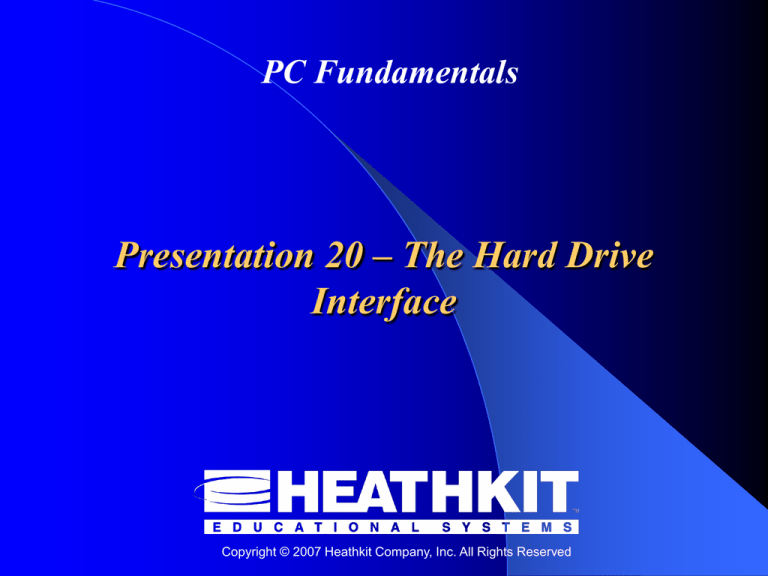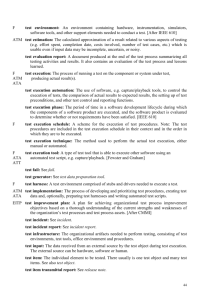
PC Fundamentals
Presentation 20 – The Hard Drive
Interface
Copyright © 2007 Heathkit Company, Inc. All Rights Reserved
Objectives
At the end of this presentation,
you will be able to:
2
Identify and describe the differences, strengths,
and specifications of IDE.
Define IDE, ATA, PATA, and SATA.
Identify the cables and connectors used with the
various types of PATA and SATA drives.
Discuss Master/slave/cable select (CSEL)
including jumper settings in PATA drives.
Explain why the hard drive interface technology
changed from parallel transfers to serial transfers.
Discuss the difference between the PATA and
SATA standards.
3
Physical Drive
Logical Drive
4
C: Heath
40 GB
Disk 0
60 GB
D: Heathkit
20 GB
5
Disk2
Disk0
C: 60GB
G: 40GB
D: 50GB
H: 40GB
10GB
20GB
Disk1
Disk3
K:50GB
E: 60GB
I: 40GB
F: 50GB
J: 30GB
10GB
10GB
6
Mass Storage Interfaces:
IDE – Integrated Drive Electronics
SCSI – Small Computer System Interface
7
Evolution of the Mass Storage
Interface
Integrated Drive Electronics (IDE)
Small Computer System Interface (SCSI)
ESDI
ST-506/412
1980
1985
1990
1995
2000
8
IDE versus SCSI
IDE used predominately in PCs.
IDE costs less than SCSI.
IDE developed primarily for “inside-the-case”
technology.
IDE has severe restrictions on cable length.
IDE allows one master and one slave for each IDE
connector on the motherboard.
Each master/slave pair requires a different IRQ.
IDE provides excellent performance in a single-user,
single-tasking operating system.
9
IDE versus SCSI
SCSI is inherently more expensive than IDE.
SCSI used predominately in Servers and
Workstations.
In multi-user, multitasking situations, SCSI is
faster than IDE.
SCSI allows more devices and a greater variety of
devices to be connected to the computer.
When multiple devices are used, SCSI requires
fewer computer resources than IDE.
10
IDE Drives
Motherboard
Slave
Master
11
IDE Drives
Secondary
Slave
Secondary
Master
Motherboard
Primary
Slave
Primary
Master
12
Integrated Drive Electronics
(IDE)
A generic term for any drive with a built-in
disk controller.
More properly called Advanced Technology
Attachment (ATA) interface because that is
the name assigned by the American
National Standards Institute for this
interface standard.
13
PIO vs. DMA
Programmed I/O (PIO) – The CPU is used
to transfer data.
Direct Memory Access (DMA) – The CPU
is not involved.
14
Bus Mastering
A technique that allows an intelligent device
to seize control of the bus to perform its
task without CPU intervention.
Allows the transfer of data from one device
to another at the maximum speed that the
bus supports.
15
The ATA Standards
ATA
ATA-2
ATA-3
ATA/ATAPI-4
ATA/ATAPI-5
ATA/ATAPI-6
ATA/ATAPI-7
Serial ATA or SATA
16
ATA
Also known as IDE
Hard disk drive interface standard
Supports PIO modes 0, 1, and 2 and DMA mode 0
PIO 0 transfer rate 3.3 megabytes/second
PIO 1 transfer rate 5.2 megabytes/second
PIO 2 transfer rate 8.3 megabytes/second
DMA 0 transfer rate 2.1 to 8.3 megabytes/second
Uses a 40-pin, 40-conductor cable
17
ATA-2
Also known as EIDE or Fast ATA
Enhanced BIOS offered new addressing
method—LBA (Logical Block Addressing)
PCI bus combined expanded data bus width
with increased speed
Operating system recognized new BIOS
features
Used a 40-pin, 40-conductor cable
18
ATA-2
Supported PIO modes 3 and 4
PIO 3 transfer rate 11.1 megabytes/second
PIO 4 transfer rate 16.7 megabytes/second
Supported DMA modes 1 and 2
DMA 1 transfer rate 13.3 megabytes/second
DMA 2 transfer rate 16.7 megabytes/second
Supported ATA legacy transfer rates
19
ATA-3
ATA-3 was a minor standard update
Data transfer reliability improved, but 40pin, 40-conductor cable remained limited to
a maximum length of 18 inches
Added SMART (Self-Monitoring Analysis
and Reporting Technology)
Password protection
20
ATAPI
AT Attachment Packet Interface
Separate standard covering CD-ROM and
tape drive storage devices
Not part of the ATA hard disk drive standard
Uses a 40-pin, 40-conductor cable
21
ATA/ATAPI-4
ATAPI added to the ATA standard
Hard drives, CD-ROM drives, tape drives,
and similar devices share same interface
standard for first time
Introduces Ultra DMA to the PC
22
ATA/ATAPI-4
Adds CRC (Cyclical Redundancy
Checking)
23
ATA/ATAPI-4
40-pin, 80-conductor cable now optional
24
ATA/ATAPI-4
Supports Ultra DMA modes 0, 1, and 2
Ultra DMA mode 0 transfer rate 16.7 MB/sec
Ultra DMA mode 1 transfer rate 25 MB/sec
Ultra DMA mode 2 transfer rate 33.3 MB/sec
Ultra DMA mode 2 is also known as UDMA/33,
UDMA mode 2, and Ultra ATA/33
25
ATA/ATAPI-4
DMA and Ultra DMA support Burst mode
Bust mode is the maximum transfer rate
Bust mode is not sustainable over time
Long-term transfers are about half the rate
of Burst mode
26
ATA/ATAPI-5
Support for Ultra DMA modes 3 and 4
Ultra DMA mode 3 transfer rate 44.4 MB/sec
Ultra DMA mode 4 transfer rate 66.7 MB/sec
Ultra DMA mode 4 is also known as UDMA/66,
UDMA mode 4, and Ultra ATA/66
Requires a 40-pin, 80-conductor cable
27
ATA/ATAPI-6
Support for Ultra DMA mode 5
Burst rate 100 MB/sec
Ultra DMA mode 5 is also known as
UDMA/100 and Ultra ATA/100
Requires a 40-pin, 80-conductor cable
28
ATA/ATAPI-6
CHS addressing no longer supported
LBA addresses extended from 28-bit to 48bit lengths (228 vs. 248)
Drives up to 137 GB in size may use either
28-bit or 48-bit addressing
Drives greater than 137 GB must use 48-bit
addressing
Drive capacities to 144 PB (144 petabytes)
29
ATA/ATAPI-7
The last standard to support parallel data
Support for Ultra DMA mode 6
Burst rate 133 MB/sec
Ultra DMA mode 6 is also known as
UDMA/133 and Ultra ATA/133
Requires a 40-pin, 80-conductor cable
30
ATA Interface Connectors
1
39
2
40
Extra 4 pins supply power
1
43
2
44
31
ATA Interface Connectors
1
39
2
40
Pin 20 Blocked
1
43
2
44
32
ATA Interface Connectors
1
39
2
40
Tab
1
43
2
44
33
Pin 1 on the cable is marked.
Pin 1
34
Typical ATA Hard Drive
Connectors
40-pin
IDE Cable
Connector
8-pin
4-pin
Jumper
Power
Connector Connector
35
Jumper
Block
M
A
S
L
C
S
36
M
A
S
L
C
S
Single Drive
Master Drive
With Slave
Slave Drive
37
The Cable Select Option
M
A
S
L
C
S
38
Jumper
Block
DS CS/SP
39
DS
CS/SP
Master Drive
Master Drive
With Slave Present
Slave Drive
Cable Select
40
Parallel ATA Versus Serial ATA
All the technologies discussed up to now
have been parallel.
–
The data bits are transferred in parallel, usually
32 bits at a time.
– Referred to today as PATA.
Serial ATA or SATA allows higher transfer
rates.
41
SATA
Serial AT Attachment (SATA) standard
Data storage standard
Interface transparent to operating system
Supports previous parallel ATA standards
Data transfer rates up to 300 MB/sec are
common.
42
SATA Interface
Signal
Cable
Connector
Cable
Assemblies
Signal
Contacts
Drive Socket
Assembly
43
SATA Interface
Drive Socket
Assembly
Power
Contacts
Power Supply
Cable Connector
Cable
Assemblies
44
SATA Interface
Drive Socket
Assembly
Manufacturer
Test Pins
Cable
Assemblies
45
SATA Hard Disk Drive
Power
Adapter Plug
Test Pins
Power
Connector
Signal
Connector
46
PC Fundamentals
End
Copyright © 2007 Heathkit Company, Inc. All Rights Reserved





